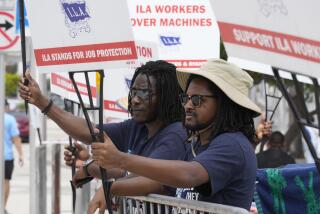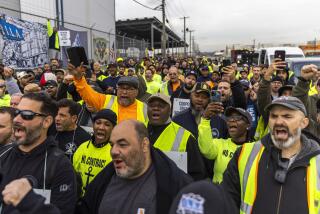Twilight of the Working Man All Too Evident at Dockside
- Share via
NEW ORLEANS — Amid the silhouettes of darkened warehouses, the longshoremen gathered before dawn, milling about the union hall’s parking lot. They had come, as they had yesterday and would tomorrow, in hopes of finding a day’s work on the docks, and what crossed their minds on these dreary mornings was this: Are those of us whose production is measured in sweat and muscle an endangered species?
The men were mostly middle-aged. They were broad-shouldered and they smoked cigarettes as they waited, collars turned up against the drizzle, to see how many foremen would be dispatched with their gangs to the docks.
The chalkboard listed only five ships that needed unloading, including the Bright Skies, a tramp freighter from Manila with a cargo of coffee, silicon slag, steel pipes and barbed wire, so two-thirds or more of the 300 men in the parking lot would not get a work call. Most would return eight hours later to try for a slot on the night shift.
“They say work’s picking up on the docks but, hell, I don’t see it,” said stevedore Marshall Jackson. “And if you’re not making your hours, you’re not making a paycheck that amounts to anything. Maybe today I’ll get my hours, then I come back tomorrow and, nothing. In this job you get hired and fired every day.”
Over the years, in poem and song, we have celebrated--and even found nobility in--the American working man who toils with brawn alone. He is the builder, the one who finishes the works that genius begins. His labor, as Ulysses S. Grant once said, authors all greatness and wealth. It is confirmation that a life fulfilled includes freedom to work, not freedom from work.
But in an era when most Americans exert more energy working out than working, when wheelbarrows are used to garden instead of to lug cement, the number of unskilled workers who survive by the sweat of their brow is growing smaller.
“Sure, if I had a choice, I’d sit at a desk with a computer, but I don’t have the education to handle it,” said Jerry Guidry. “A strong back, a weak mind and a lot of common sense--that’s what you need on the docks, not a degree.”
He said this believing that tough labor was an honorable endeavor and that he and his colleagues worked not for any lofty goals, but merely to survive.
Guidry also knows that he may be the last of a generation. White-collar workers have outnumbered blue-collar workers in the United States since 1981.
One million new college graduates are turned loose on the job market every year, and between 1990 and 2005, the Department of Labor says, employment requiring college degrees is expected to increase 39%--twice as fast as the rate of total job growth.
“OK, we’ve got a job on the Nashville wharf,” Guidry’s foreman said. Guidry and the dozen men in his gang got into their cars and drove out of the parking lot in the first light of dawn. The streets were deserted. A few miles away they turned into the port and parked near the Bright Skies, a ratty-looking old freighter that appeared barely seaworthy.
Within minutes the wharf on the banks of the Mississippi was alive with forklifts, scurrying stevedores, sacksweepers, water boys, coopers and freight-handlers.
Pallets loaded with sacks of coffee swung overhead, hooks dangling from the arms of cranes flashed to and fro and men sweated and cursed as they lashed steel beams in the bowels of a musty hold.
The company man who stood on the pier, clipboard in hand, directing the cargo to waiting trailer-trucks and rail cars or into the warehouse, said he considered New Orleans’ longshoremen among the best in the nation.
“You don’t hear a lot of bitching from them about what they will and won’t do,” he said. “They just do the job and the cargo moves. That’s how it’s always been in this port, long as I remember.”
Back in the days when the International Longshoremen’s Assn. had 12,000 workers in New Orleans--about 10 times the number of members it has now--a job on the docks was so coveted that foremen handed out slots through patronage and expected a weekly “rebate” for putting a man to work.
“You had to kiss ass to get a job and break ass to keep it,” one stevedore said, “but it was worth it.”
The docks attracted the poor African Americans off the farms and the impoverished Irish and Italian immigrants from their row houses and, with work steady and overtime generous, gave rise to a new middle class.
Although blacks and whites maintained separate unions until the early 1970s, the unskilled waterfront workers forged a movement that gave them considerable management control and helped bridge the gap between races.
But like other groups of unskilled workers, the longshoremen have seen an erosion of their power--and pay--in recent years. Container shipping, introduced in 1958, reduced the need for manpower. In 1986 the ILA, bargaining from a position of weakness, was forced to make concessions: Pay was reduced from $17 an hour to $14 (it’s now back up to $16.50), the number of guaranteed hours in rain-shortened workdays was cut from eight to four, some benefits were reduced.
At the same time steady work and overtime was becoming sparser with increased automation, non-union companies were born that paid their workers $8 to $10 an hour, with no benefits.
“Back in ‘79, I was making $30,000,” said James Jackson, who later lost his union card because of insufficient work hours. “Now I’ve got a non-union job on the docks and I’m at ($14,000), living week to week, with no medical, no pension, no nothing. I’ll tell you this, this is no job you’d want to send your son into.”
Few stevedores would have said that a generation ago. Jules Ducros said he remembers how his father counseled him as a teen-ager: “It’s hard work on the docks, but there’s nowhere else you’re going to make this kind of money.”
When Ducros was married by a justice of the peace at age 17, his father called before sunup the next morning. “Since you got married, son,” he said, “it’s time you got to work.” Ducros met his father at the union hall an hour later, worked until midnight that day, and is still on the docks today, 24 years later.
Ducros--whose father fell to his death from a ship in 1975--is the last of three generations of stevedores. He said he was not surprised when his son decided to become an air-conditioning specialist.
Although union longshoremen can still make $30,000 a year and are covered by a good health plan, there are less-dangerous, more-secure jobs available in port cities today. As with the paper mills of New England, the mines of West Virginia and the forests of the Pacific Northwest, young men are no longer inclined to take up the tough dead-end jobs that sustained their fathers.
“There’s no security left on the river,” said Lamar Hooks, 62. “That’s why you don’t see any young people out here any more. But at one time the docks were full of young people. They were everywhere. Hell, we were all young once here.”
The Bright Skies was unloaded by late afternoon, pulled anchor and headed toward the Gulf of Mexico. When Hooks was young and cargo came off on a man’s back instead of a crane-lifted pallet, the job would have taken three or four days; Bright Skies had been emptied in 10 hours.
The stevedores drifted off, yellow hard hats under their arms, to begin anew their search for a new ship and another day’s pay at the union hiring hall in the darkness of tomorrow’s morning.
More to Read
Sign up for Essential California
The most important California stories and recommendations in your inbox every morning.
You may occasionally receive promotional content from the Los Angeles Times.













